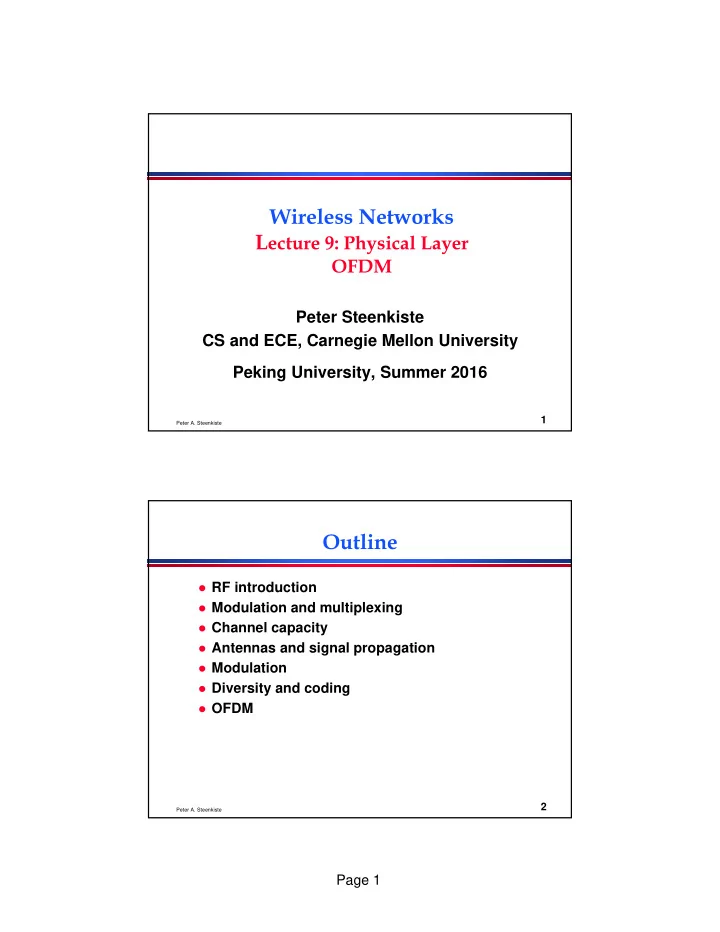

Wireless Networks L ecture 9: Physical Layer OFDM Peter Steenkiste CS and ECE, Carnegie Mellon University Peking University, Summer 2016 1 Peter A. Steenkiste Outline RF introduction Modulation and multiplexing Channel capacity Antennas and signal propagation Modulation Diversity and coding OFDM 2 Peter A. Steenkiste Page 1
How Do We Increase Rates? Two challenges related to multipath: As rates increase, symbol times shrink and the effects of inter-symbol interference becomes more pronounced » See earlier examples Frequency selective fading starts to have a bigger impact because there is less redundancy in the signal We would like an encoding and modulation solution that has longer symbol times and allows us to fight frequency selective fading more effectively 3 Peter A. Steenkiste Inter-Symbol-Interference Transmitted signal: Received Signals: Line-of-sight: Reflected: The symbols add up Delays on the channel Distortion! 4 Peter A. Steenkiste Page 2
Frequency-Selective Radio Channel Power response [dB] 20 15 10 5 0 -5 -10 Frequency Interference of reflected and LOS radio waves results in frequency dependent fading Impact is reduced for narrow channels 5 Peter A. Steenkiste OFDM - Orthogonal Frequency Division Multiplexing Distribute bits over N subcarriers that use different frequencies in the band B » Multi-carrier modulation » Each signal uses ~B/N bandwidth Since each subcarrier only encodes 1/N of the bit stream, each symbol takes N times longer in time Since signals are narrower, fighting frequency selective fading is easier 6 Peter A. Steenkiste Page 3
OFDM Transmission Frequency Frequency selective fading distorts wide-band signals Time Multipath causes ISI Frequency Narrow band signals Time Longer symbols 7 Peter A. Steenkiste Fighting ISI Frequency selective fading will only affects some subcarriers » May be able to simply amplify affected subcarriers » No need for complex dynamic equalizer – Become less effective with shorter symbols Further reduce ISI effects by sending a “cyclic prefix” before every burst of symbols » Can be used to absorb delayed copies of real symbols, without affecting the symbols in the next burst » Prefix is a copy of the tail of the symbol burst to maintain a smooth symbol » E.g. a cyclic prefix of 64 symbols and data bursts of 256 symbols using QPSK modulation 8 Peter A. Steenkiste Page 4
Adjacent Symbol Interference (ASI) Symbol Smearing Due to Channel Slide Prof Harris, SDSU 9 Peter A. Steenkiste Guard Interval Inserted Between Adjacent Symbols to Suppress ASI Slide Prof Harris, SDSU 10 Peter A. Steenkiste Page 5
Cyclic Prefix Inserted in Guard Interval to Suppress Adjacent Channel Interference (ACI) Slide Prof Harris, SDSU 11 Peter A. Steenkiste Use of Redundancy in OFDM OFDM uses error coding as described earlier » The degree of error coding can be adjusted based on channel conditions OFDM offers frequency diversity » Frequency: data is spread out over multiple subcarriers Time Frequency Combining OFDM with MIMO adds space diversity 12 Peter A. Steenkiste Page 6
Example: 802.11a Uses OFDM with up to 48 subcarriers » Used for data, pilots for control, and guard bands Subcarrier spacing is 0.3125 MHz Subcarriers are modulated using BPSK, QPSK, } 16-QAM, and 64-QAM Uses a convolutional code at a rate of ½, 2/3, ¾ , or 5/6 to provide forward error correction Results in data rates of 6, 9, 12, 18, 24, 36, 48, and 54 MBps Cyclic prefix is 25% of a symbol burst (16 vs 64) OFDM is also used for the higher 802.11g rates 13 Peter A. Steenkiste Discussion OFDM is very effective in fighting frequency selective fading and ISI Finally a free lunch? No – you introduce some overhead » Frequency: you need space between the sub carriers » Time: You need to insert prefixes You also add complexity » How do you create many, closely spaced subcarriers? » The OFDM signal is fairly flat in the frequency domain, so it is very variable in the time domain – High peak-to-average Power ratio (PAPR) – Can be a problem for simple, mobile devices 14 Peter A. Steenkiste Page 7
Subcarriers are “Orthogonal” Peaks of spectral density of each carrier coincide with the zeros of the other carriers » Carriers can be packed very densely with minimal interference » Requires very good control over frequencies 15 Peter A. Steenkiste Densely Packing OFDM Channels Ch.1 Ch.2 Ch.3 Ch.4 Ch.5 Ch.6 Ch.7 Ch.8 Ch.9 Ch.10 Conventional multicarrier techniques frequency Ch.2 Ch.4 Ch.6 Ch.8 Ch.10 Ch.1 Ch.3 Ch.5 Ch.7 Ch.9 Saving of bandwidth 50% bandwidth saving Orthogonal multicarrier techniques frequency 16 Peter A. Steenkiste Page 8
OFDM Spectrum Use 17 Peter A. Steenkiste Implementing OFDM The naïve approach is to modulate individual subcarriers and move them each to the right frequency » Not practical: the subcarriers are packed very densely and their spacing must be very precise » Also complicated: lots of signals to deal with! How it works: Radio modulates the subcarriers and combines them in the digital domain and then converts the signal to the analog domain » The details do not matter for this course 18 Peter A. Steenkiste Page 9
OFDM in 802.11 Uses punctured code: add redundancy and then drop some bits to reach a certain level of redundancy 19 Peter A. Steenkiste Summary OFDM fights frequency selective fading and inter-symbol interface to increase rates » Both become more significant at higher rates It modules a large number of narrow-band signals (subcarriers) instead of a single wide channel Cyclic prefixes are used to separate symbols It uses time and frequency diversity, combined with coding to reduce the effect of fading 20 Peter A. Steenkiste Page 10
Recommend
More recommend